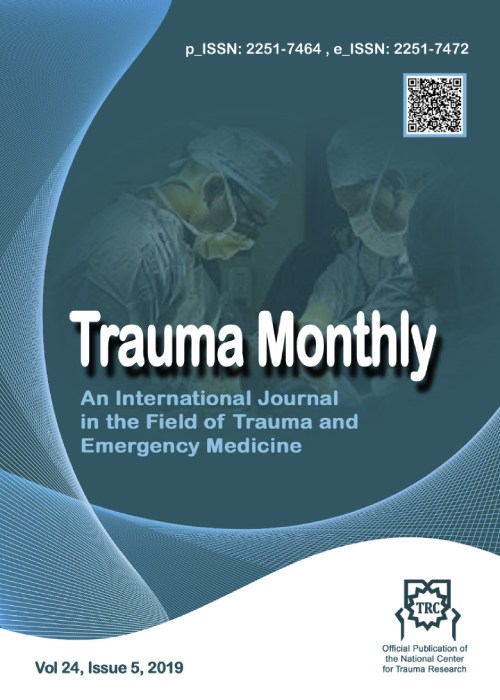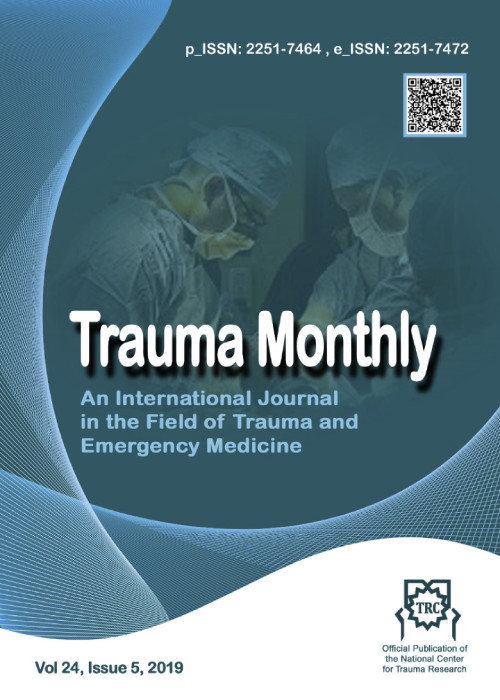فهرست مطالب

Trauma Monthly
Volume:28 Issue: 1, Jan-Feb 2023
- تاریخ انتشار: 1402/01/15
- تعداد عناوین: 7
-
-
Pages 678-686IntroductionNon-Governmental Organizations (NGOs) play a vital role in accurate disaster management. This study aimed to Investigate factors affecting the participation of NGOs in disaster management in Iran.MethodThis qualitative study was conducted via content analysis approach. This study comprised 32 participants, including four managers of municipalities and governorates, four health ministry managers, five managers of Red Crescent Society, five faculty members of the university who work on disaster management, and fourteen managers/secretaries of NGOs. They had knowledge or practical experience in disaster management. The abovementioned people were interviewed. The data were collected through purposive sampling, which continued until data saturation was reached.ResultsFactors affecting the participation of NGOs in disaster management were classified into 4 main categories and 14 subcategories, including organizational and managerial, field and operational, social and cultural, and policymaking factors.ConclusionAccording to the results of this study, as multiple NGOs take part in responding to disasters and performing relief operations, establishing a unified command and supervision system for effective coordination and collaborations among NGOs and other stakeholders is highly suggested. The future national plans and strategies of disaster management need to consider the supportive rules and reform inappropriate legal barriers to NGOs’ participation in disaster management activities. All organizations involved in disaster response must play a vital role in making disaster management decisions for every country to consider all important aspects and issues.Keywords: Disasters, Management, NGOs, Participation
-
Pages 687-693IntroductionTrauma injuries in overcrowding ceremonies are frequent. This study assessed the health system's challenges in preventing trauma incidents at the Arbaeen ceremony.MethodsThis qualitative research from June 2021 to January 2022 included ten experts: three trauma professors, four crisis management professors, and three emergency medicine professors. Semi-structured interviews were used for the assessment of data. Challenges and suggestions regarding trauma prevention in the Arbaeen pilgrimage were coded and extracted.ResultsThe findings related to the factors causing trauma in the Arbaeen ceremony were identified in four themes: management and policy-making, education, resort locations, and traffic. These themes were extracted from a total of 71 codes. The education content included general education, specialized health education, and education in spiritual health. The traffic issues included three subcategories in Iran, Iraq, and around the holy shrines, and resorts and settlements with three subcategories of processions, places of rest, and medical centers.ConclusionPilgrim-oriented education, planning, and control of other challenges can reduce threats into opportunities and improve participants' health in the Arbaeen community.Keywords: Arbaeen, Pilgrimage, Trauma
-
Pages 694-714Background
In the last decade, the number of religious mass gathering ceremonies, which take place in Iraq, has increased considerably. Millions of participants visit the country annually from across the world to reach Karbala on foot or by other vehicles for participation in a religious ritual called Arbaeen, which lasts about 20 days. Unlike the Hajj mass gathering, another important annual religious mass gathering event of Muslims, an evidence-based review of scientific literature about influential factors on the health of participants in these ceremonies in Iraq has not been done.
MethodsUsing PRISMA guidelines and searching PubMed, Scopus, ISI_Web of Science, Cochrane Library, ProQuest, and Google Scholar databases, original English language studies focused on participants' health in religious ceremonies of Iraq until October 2021 were selected. The methodological quality of the studies and the risk of bias were checked using the Joanna Briggs Institute (JBI) checklists.In addition, the data from the Iraqi Ministry of Health and other organizations, including WHO and CDC, about Iraq's health condition and other resources were used to describe the related findings better and make health recommendations for the participants.
ResultsThirty-two studies passed our criteria and were included for analysis. There was not any clinical trial. All of them were observational (cross-sectional) or qualitative (interview) research; the majority had low to moderate quality scores. Considering the limitations, the leading health risks of participants in religious ceremonies in Iraq include road accidents, insufficiency of Iraq's health system, cardiovascular disease, respiratory tract (including Covid-19) infections, unhealthy food and drink, gastrointestinal infections (including hepatitis), and zoonotic infections(leishmaniasis).
ConclusionRegarding the grandeur of Iraqi-related mass gatherings, preparation must begin before the events. Pre-participation examination, vaccination of high-risk individuals, and training of pilgrims and authorities on the health hazards are critical.
Keywords: Infectious Disease, Travel Medicine, Arbaeen, Ashura, Disaster Medicine -
Pages 715-719Introduction
Complete dislocation of the tarsal navicular without fracture is an uncommon injury. The rarity of this injury can be attributed to the rigid bony and ligamentous support surrounding the navicular, which usually undergoes fracture and dislocation rather than the pure dislocation of the navicular.
Case presentationThis manuscript reports a case with isolated navicular dislocation following a fall and successful treatment via open reduction and fixation with K-wire.
ConclusionAlthough pure navicular dislocation is uncommon, it should be considered in patients with foot trauma, and treatment decreases complications.
Keywords: Navicular dislocation, Midfoot Injury, reduction -
Pages 718-726IntroductionRadial head resection has been necessary in cases of radial fragmentation. We assessed the results of radial head resection in patients with the terrible triad.MethodThirteen patients with terrible triads who had undergone radial head resection and lateral collateral ligament (LCL) repair by a single surgeon from 2004 to late 2020 were studied. Patients were followed for one year and evaluated in terms of the range of motion (ROM), the efficiency of the relevant organ, and radiological factors in patients who could not visit in person; the evaluations were performed using the software. Movements were evaluated with a metal goniometer, and the efficiency was measured using the disability of the arm, shoulder, and hand (DASH), the Mayo elbow performance (MEPS), and the visual analog scale (VAS) scores. The patient's radiography was evaluated for the elbow joint's instability and degree of osteoarthritis.ResultsThe mean duration of injury to surgery was 7.30 ± 2.15 days, and the mean follow-up period was 35.19 ± 2.85 months; the mean ROM (Pas, Act) rate was equal to 126.33 ± 10.49 degrees. None of the patients met the criteria for joint instability; of 13 patients, seven were completely satisfied with the surgery, and two returned to their previous jobs. The mean total pain score according to the VAS criteria was 2.6.ConclusionRadial head resection and LCL repair in the terrible triad of the elbow led to the individual's improved performance and the patient's reduced pain severity and satisfaction.Keywords: Terrible triad, Elbow Joint, Radial head resection, Lateral collateral ligament repair
-
Pages 727-733IntroductionInjury from animal attacks is an important public health problem with high morbidity and mortality. As we cannot neglect or underestimate these hazardous conditions, we aimed to assess animal-related injuries in Iranian patients and compare the results.MethodsIn this cross-sectional study conducted on data from the National Trauma Registry of Iran, trauma patients admitted to the hospital due to animal attacks from January 15, 2018, to November 1, 2021, were assessed. A checklist gathered data consisting of baseline characteristics such as sex, age, activity, place at the time of the attack, and injury site. In addition, we extracted the clinical features of these patients, including injury severity score, Glasgow coma scale, intensive care unit (ICU) admission, hospital length of stay, surgery, and discharge status.ResultsOne hundred thirty-one patients were registered in the study. Most of the patients were male (80.9%), aged 16 to 44 years (59.5%), and encountered animal attacks when they were in agricultural areas (45%). Ninety-six patients (73.3%) underwent surgery, and three were hospitalized in ICUs. We recorded 172 injuries, consisting of 92 (53.5%) injuries in the upper extremities as the most common region of the body. The males were aged 16-44 years (66%), and the females were aged 45-65 (52%) (P=0.005). Fifty percent of males and 24% of females were injured in the agricultural areas. Moreover, 24% of females and 6.6% of males were injured at home.ConclusionThis study showed a high incidence animal attacks in Iran. Most injuries were in middle aged males and in the agricultural area.Keywords: animals, Trauma Centers, Wounds, Injuries
-
Pages 734-747BackgroundInfectious wounds are one of the most important problems of today's society, which lead to a delay in the stages of wound healing. Pseudomonas aeruginosa is one of the most common infections in trauma wounds. Ganoderma as an important mushroom with bioactive compounds that has been widely used in traditional medicine on P. aeruginosa. This study aimed to assess effectiveness and antimicrobial properties in this mushroom on P. aeruginosa.MethodsPolysaccharide compound was extracted from the Ganoderma lucidum mushroom by the Soxhlet method and then purified, and the determination of concentration and characterization was done by FTIR method. Then, effect of polysaccharide on P. aeruginosa ATCC 9027 was evaluated on MIC and MBC by broth dilution tests. Next, alginate/collagen polysaccharide hydrogel was synthesized by thermal method and the toxicity was evaluated on L929 mouse fibroblast cell line. Fifteen male Wistar rats were randomly divided into three groups namely control, positive control, and Al/col/Ps. Histopathological changes were studied. Data were analyzed using SPSS 26 and non-parametric Kruskal-Wallis and Mann-Whitney tests.ResultsMIC and MBC concentration of the polysaccharide compound against Pseudomonas aeruginosa were calculated as 1.56 and 3.13 mg/ml, respectively. In this study, the sample cell viability with an acceptable survival rate of > 70% (toxicity < 30-35%) was the same as the control, indicating non-toxicity compared to the control sample. According to wound histopathology, wound closure (86%), fibroblast 18520, hair follicle 4, angiogenesis, collagen, and epidermis were significantly higher in the Al/col/Ps system group compared to the control group.ConclusionIn addition to antimicrobial activity against the standard P. aeruginosa, the extracted polysaccharide plays a significant role in infectious traumatic wound. Our results demonstrate that the Al/col/Ps hydrogel system can be recommended as a potential treatment for trauma wound infections.Keywords: Polysaccharide, Pseudomonas aeruginosa, wound healing


